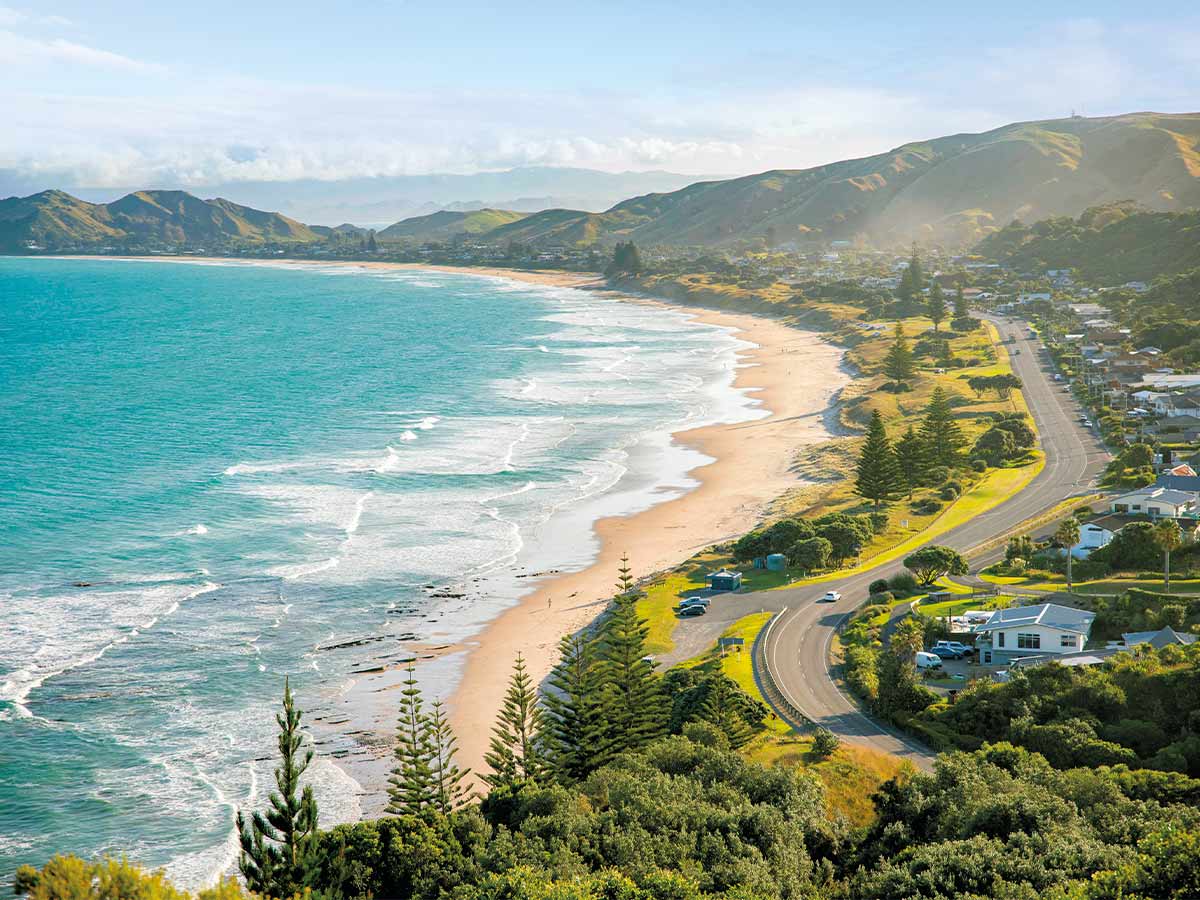Kicking off a new year often comes with a renewed sense of purpose. MCD editor Lisa Potter wasted no time setting off on her first trip for 2024, taking the road less travelled and exploring all 334km of the infamous East Coast on Highway 35.
The East Coast experience gives true meaning to the saying “life is about the journey, not the destination.”
While the end destination of Gisborne, the East Cape is definitely worth the drive either way you decide to head, there’s no denying that opting for the more remote and winding East Coast roads offers a memorable journey in itself and one that deserves to be experienced. There’s something about the simple joy of this windswept and rugged landscape that truly encapsulates the soul of New Zealand.
These days, it’s rare to choose the longer option between two destination points. Most of us are in a rush to get to where we’re going, but embarking on this drive somehow eases you into a more relaxed state of mind. There are no distractions of large commercial or tourist ventures, and no interchangeable shopping malls to mindlessly meander through.
This trip is about slowing down (literally) and being in the moment. Around every corner is a fresh landscape, secluded beach, or hidden bay. It’s a true journey of discovery and for a first-timer, these parts yield surprise after surprise. The dress code is relaxed Kiwi – shorts and jandals, and it’s also time to rediscover your love of pies, with tempting treats, such as the pāua pie at Café 35 (Tokomaru Bay) and the parango (seaweed and bacon) offering from Te Puia Springs café.
Ōpōtiki
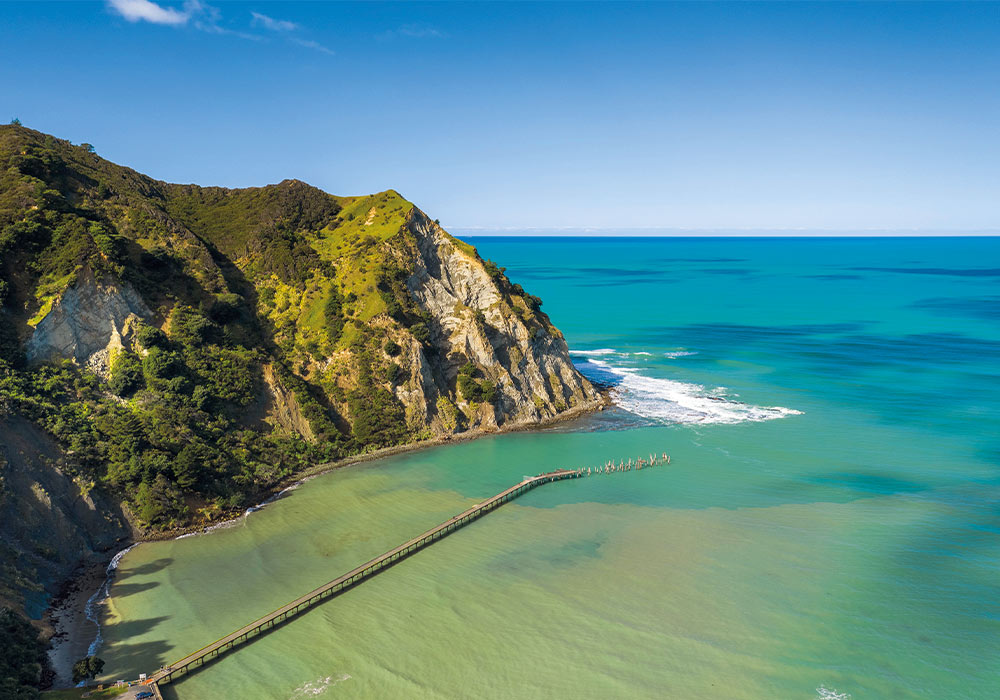
Sitting at the edge of the Bay of Plenty, Ōpōtiki borders the northern gateway to Tairāwhiti and is the access way to the iconic State Highway 35. If you’ve got a little extra time in hand, stay awhile in Ōpōtiki, as it’s also the best base for the Motu Trails cycleway and a host of other excellent mountain biking and tramping tracks. It pays to pause here and stock up on a few supplies for the trip ahead, even if it’s just cold water and some snacks. Having said that, it’s not far to the first stop I’d recommend: Pacific Coast Macadamias, where a small plantation of macadamia trees bask under the Raukumara Range, making the most of the subtropical sun. Nut House Café is open until 3pm over the summer months until Easter weekend, and I can vouch for the spicy macadamia nuts and macadamia nut oil. I had ordered this luscious oil previously online and was already a fan, so it added to the connection of supporting a small New Zealand business by being able to see the orchard firsthand.
Bays for Days
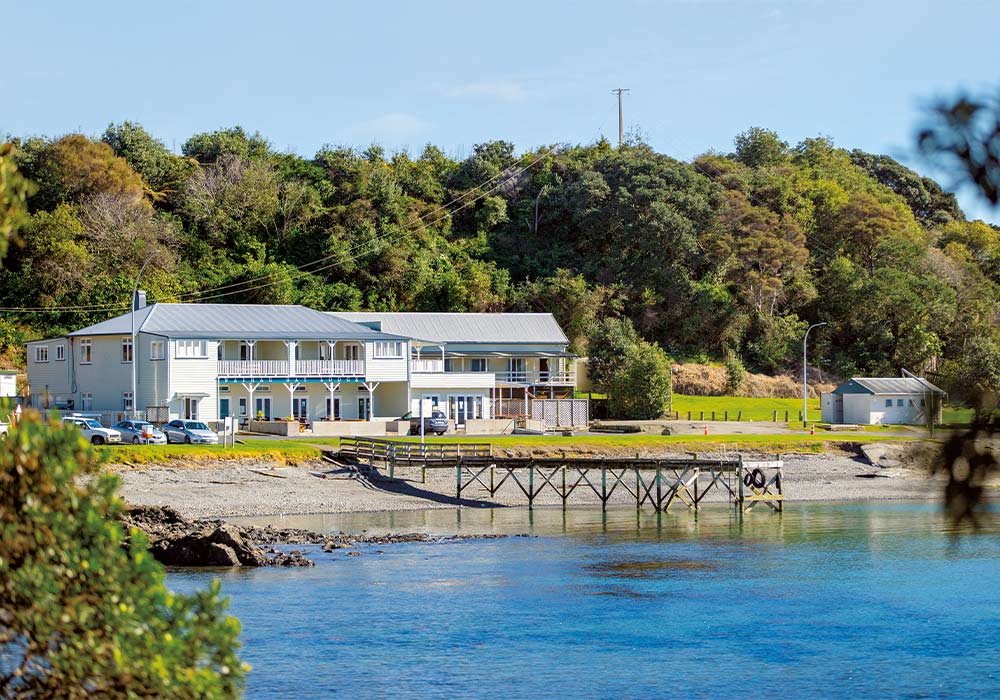
There’s a seemingly endless array of bays along SH35, and each and every one deserves exploration. So, either tack on a few days to your trip so you can truly indulge in this rich offering or plan a second trip to make sure you leave nothing undiscovered.
Each bay has its own unique flavour but there’s a common denominator; no matter how far off the beaten track you go, there’s a wave, a smile, or a Kia ora from friendly locals.
From Ōpōtiki, there’s Whituare Bay, Omaio Bay, Te Kaha, Waikawa Point, Whanarua Bay, Maraehako Bay, and Papatea Bay – all of this before we even make it to our first stop for the night, Waihau Bay. All are worth taking some time to enjoy, but we settled on Waihau Bay Lodge for our evening meal and accommodation, sharing the jetty, boat ramp, and ocean views with locals, holidaymakers, and keen anglers lured by the appeal of deep-sea fish not too far from shore.
There’s plenty to choose from at the Lodge, from the menu to a choice of a backpacker hostel, chalets, and in-house rooms. The night we stayed, tents were pitched alongside on the grassy area. Next door is a Post Office (general store) founded by James Baker in the 1870s. You’ll also find plenty of information here on what’s happening on the coast and any planned activities and events.
Lured by the majestic sunrise that we sat in awe alongside local seagulls, it was an early start to the day and we set off in plenty of time to ensure we could stop off at Whangaparāoa Bay, Cape Runaway, Potikirua Point, Lottin Point (only for the very bravest of RV drivers but absolutely worth a visit), Hicks Bay, also known as Wharekahika, (absolutely delightful), Matamanoa Point, and Te Araroa (where you’ll find the majestic oldest and largest pohutukawa tree – Te Waha o Rerekohu – at Kawakawa Bay, and home to Te Araroa NZMCA Park).
All roads lead to Tairāwhiti
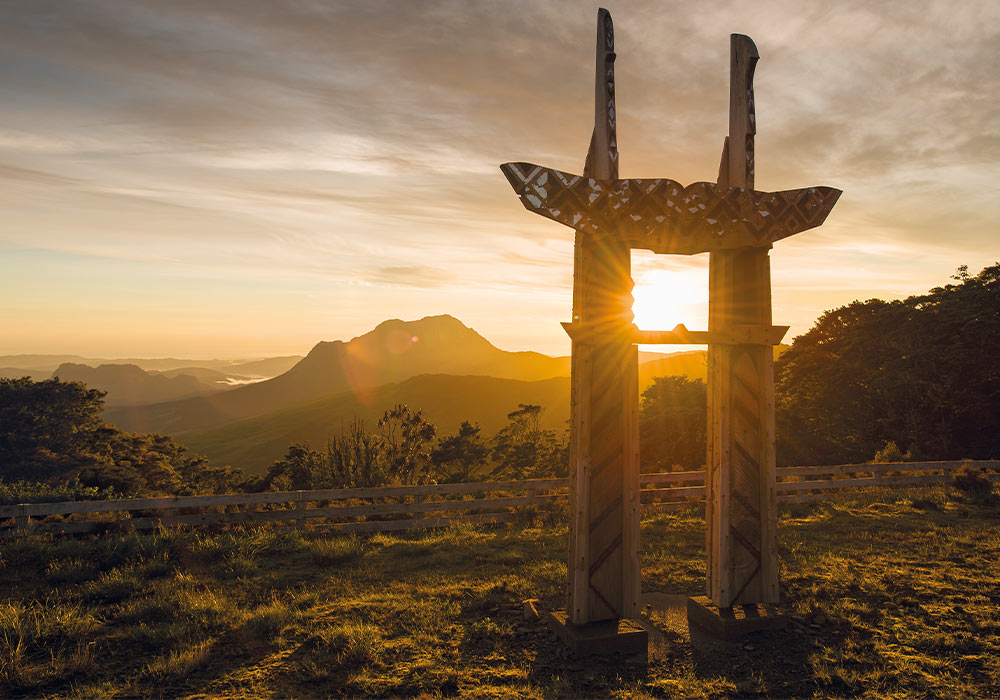
It’s a long and leisurely trip along SH35, made all the more poignant by the fact we were travelling almost one year to the day since Cyclone Gabrielle left severe road and land damage, as well as isolating many of the small communities.
The East Coast carries a long and strong legacy of pride, and while pockets of the landscape have changed, likely forever, that pride and community remain constant.
Although many of the smaller settlements and businesses are still recovering from Cyclone Gabrielle and limited access along SH35, it’s now full steam ahead with all roads open and the scenic beauty along the way a new kind of mesmerising.
Don’t get me wrong; this rugged landscape bears many deep scars of flooding and damage, and it’s slightly shocking to see the piles of forestry slash offering glimpses into the magnitude of this devastation. For now, however, many repairs have been done, and SH35 beckons in all of its glory.
Another notable stand out of the coastal drive is the rich tapestry of Marae, each with its own ornately carved gateway and deep connection and history with this landscape.
Onwards eastwards
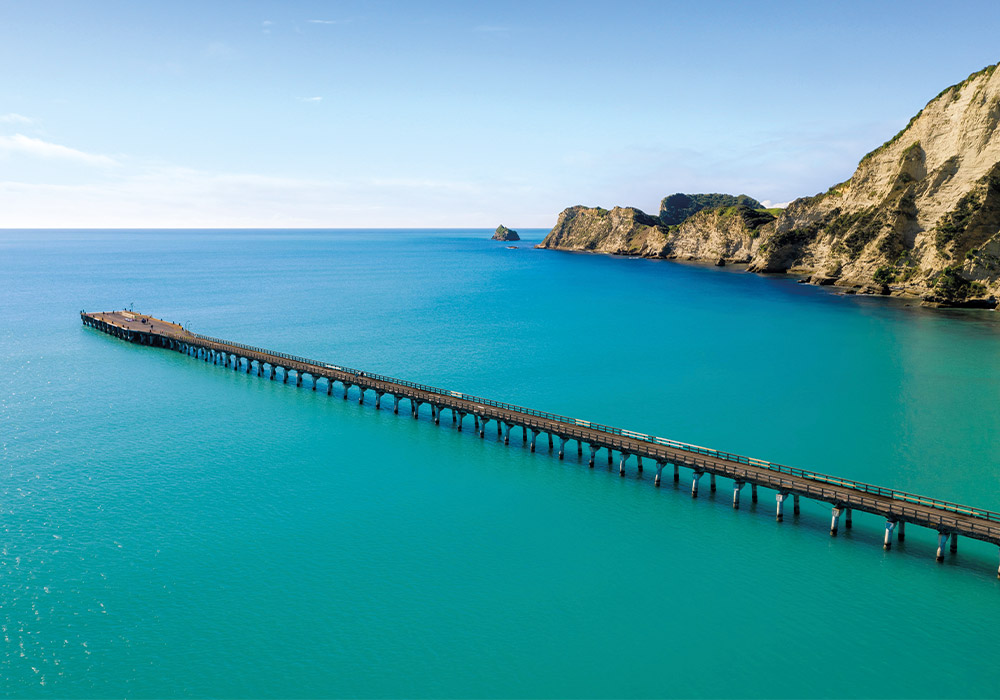
From Te Araroa and its no exit road to the historic East Cape lighthouse, the most easterly point on mainland New Zealand, (the walk to the lighthouse is currently closed – 700 steps to save for a return trip but you can still capture a great view along the rugged road), we continue towards Tikitiki, pulling over for a quick explore of the delightful St Mary’s Church. Standing as a memorial to the East Coast Māori men who fought and died in World War I, it’s still an active place of worship. A Category 1 Historic Place featuring wonderful carvings, tukutuku (woven panels) and Māori architectural design, this is surely one of the most beautiful churches in New Zealand.
Ruatoria is renowned globally and many flock to welcome the first light at Maunga Hikurangi, the first place in the world to see the sunrise each day. Add extra time to your trip to allow for a stop here and perhaps take part in the exceptional Te Urunga-Tu Sunrise Experience where you can stand amidst nine carve pou, share in the history of Ngāti Porou, and participate in a karakia (traditional Māori blessing).
Tokomaru Bay was our lunchtime destination (those Café 35 pies have a well-earned reputation), first we whet our appetite with a quick stop at Te Puia Springs for a coffee (and yes, a parango pie), as well as a quick stroll along Waipiro Bay where keen anglers were already trying their luck. There’s also Te Puka Tavern in Tokomaru Bay, a local meeting place and stop-off for travellers for more than 100 years.
It’s hard to resist the lure of white sandy beaches and sparkling clear water at Tokomaru, so we head straight for the ocean to cool our feet off. Fortified by that creamy pāua pie from Café 35, we sit awhile and watch youngsters building a wooden teepee from driftwood. Many of these are dotted along the east coast beaches – a useful way of utilising some of that slash that still remains. Once the heart of Tokomaru and its thriving freezing and shipping industries, Tokoroaru Bay Wharf stand today as a reminder of its historical significance. It’s the first of our wharf explorations before we head for Tolaga Bay, one of the top 100 historic sites in
the country.
This iconic wharf is believed to be the longest of its type in the Southern Hemisphere and while it was closed on the day, we were there awaiting a check-up, it’s usually open to the public. We had to settle for exploring underneath the structure (perhaps equally fascinating) and taking in the majestic cliffs alongside.
If you fancy a memorable walk, Cooks Cove Walkway takes you through farmland and past Te Kotere o te Whenua (the hole in the wall) to a safe swimming cove (it’s just under six kilometres so allow about 2.5 hours). Information panels dot the walkway telling stories of Cook and the crew of Endeavour’s visit to Opoutama (Cooks Cove). Also accessible on this walk is Te Pourewa (Beacon of Light), a 12-metre high sculpture that’s an important piece of Māori art commemorating the dual heritage and shared future of Aotearoa New Zealand.
If you’re torn between Tokomaru and Tolaga Bay, settle down at Anaura Bay Family Motor Camp overnight, offering exceptional beachfront camping. With Gisborne being our next destination (more on this next month), we farewell Tolaga Bay to soak in more spectacular coastal driving before arriving at Tatapouri Bay oceanside accommodation, where we happily stayed for two nights. This truly unique camping ground has been reinvigorated recently and has become something of a drawcard not just for visitors, but also for locals, enticed by the relaxing vibe, stellar coffee, and dreamy bagels. The beachside location is an enticing stay for motorhomers, caravanners, and campers, as well as those looking to relax and enjoy the offerings of glamping tents, a tiny house, zen cabins, little villas, and even log cabins (you can look forward to a future article dedicated solely to Tatapouri).
It’s also within walking distance to Dive Tatapouri, which provided one of the absolute highlights of our trip: feeding and touching stingrays and eagle rays in their natural habitat, under the guidance of experienced locals.
What a sweet way to kick off 2024 and reconnect with the landscape and beauty of the East Coast and Tairāwhiti Gisborne.
Where to stay: camping sites
If it’s summer and you’d love to camp at the stunning Kaiaua Beach, Tolaga Bay, and Tokomaru Bay (freedom camping at these sites is prohibited in summer) and other great camping sites. Just buy a permit – it’s easy!
Permits for summer camping are $18 for up to two nights. You can purchase permits online from the Gisborne District Council website and Ōpōtiki, Wairoa, or Gisborne i-SITE Visitor Information Centres.

